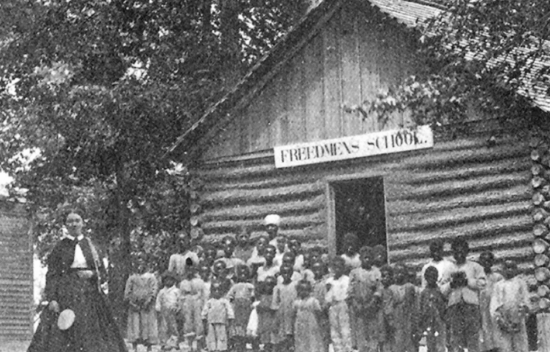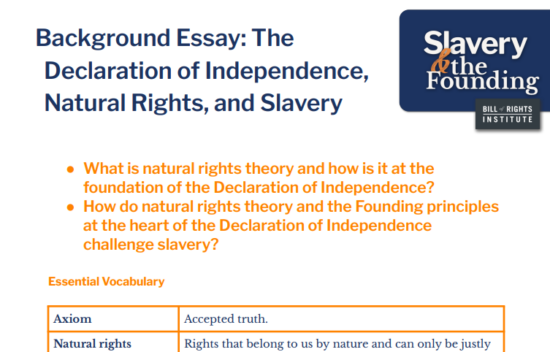
Reconstruction and Resistance: Black Codes and the Ku Klux Klan
Guiding Questions
- What were the experiences of African Americans during Reconstruction?
- How did Reconstruction impact the lives of formerly enslaved people and their families?
Objectives
- Analyze primary sources related to Black Codes and the Ku Klux Klan.
- Examine how Reconstruction policies and social dynamics affected the lives of formerly enslaved people.
- Discuss the impact of violence and discriminatory laws on the efforts to build a new social order.
Resources
Student Resources:
- Reconstruction and Resistance: Black Codes and the Ku Klux Klan Anticipation Guide
- Reconstruction and Resistance: Black Codes and the Ku Klux Klan Primary Source Set
- Index Cards (3 per student)
Teacher Resources:
- For more information and examples of analysis of “The Union as It Was” cartoon by Thomas Nash, view this BRIdge from the Past video around the 9:30 mark.
Facilitation Notes
- This may be students’ first in-depth exploration of the violent aftermath of the Civil War, particularly how Black Codes and groups like the Ku Klux Klan emerged to enforce racial oppression. Because of the sensitive nature and the violation of fundamental rights that occurred during this time period, it’s critical for the teacher to guide students through this material. The intent is to help students contextualize these events without leaving them to independently process the intensity of the violence and injustice.
- In this lesson, students will analyze three primary sources. There are five primary sources listed for the teacher to select based on the needs of their students. You should begin with the political cartoon image. Then select one Black Code text and one Ku Klux Klan text to analyze.
Anticipate
- When teaching sensitive topics like the history of the Ku Klux Klan and racism, it’s
essential to create a learning environment where students feel comfortable sharing
their thoughts, feelings, and understanding without fear of judgment. One effective
technique for gauging student comfort levels is through a simple “thumbs” check-in:- Introduce Confidential Check-Ins: Explain the purpose of “thumbs check-ins”
for private feedback. Let students know they’ll communicate their comfort
level by signaling with their thumbs while keeping their eyes closed, ensuring
confidentiality and reducing any social pressure. - Three-Level Feedback System:
- Thumbs-up: They’re feeling ready to continue with the topic.
- Thumb-sideways: They feel uncertain or could use a bit more time or support.
- Thumbs-down: They’re struggling or need a break.
- Implementation: Prompt students to close their eyes and signal their level by
holding their thumb up, sideways, or down. Quickly gauge responses and then
direct the lesson accordingly based on student needs.
- Introduce Confidential Check-Ins: Explain the purpose of “thumbs check-ins”
Engage
- Use the Anticipation Guide to ask students to express their opinions about lessons ideas and themes before they encounter them in the primary sources. The statements are designed to prepare students to explore complex themes related to the Ku Klux Klan and Black Codes during the Reconstruction era. These statements focus on justice, equality, fear, and freedom, encouraging students to connect historical themes to universal ideas and their own perspectives. You may use some or all of these statements.
- Transition: Now that you’ve reflected on these statements, we’re ready to explore how these
ideas took shape during Reconstruction. As we examine primary sources related to the Ku
Klux Klan and Black Codes, think about how the statements connect to the real challenges
people faced. Consider how issues of justice, equality, and fear impacted individuals and
communities
Explore
- Students will analyze three primary sources, each using a different method to encourage varied approaches to critical thinking. For the first primary source, an image, students will use the “See, Think, Wonder” method. Work as a class to demonstrate the skills needed to analyze the sources. The second primary source is a text, analyzed using the 3-2-1 method, where students identify 3 key ideas, make 2 connections, and pose 1 question. Again, do this work as a class to demonstrate how to analyze a text. For the final primary source, students will use the “Save the Last Word” method in small groups, where each student has the opportunity to share insights while others listen and respond. Conclude the activity with a
class debrief to reinforce key takeaways and encourage reflection on the analysis process. - See, Think, Wonder
- Display the image “The Union As It Was”, Thomas Nast, 1874 or pass out copies to
students from the Primary Source Set. - Pose the following three questions in order. Pause after each question to give
students time to reflect.- What do you see? What details stand out? (At this stage, elicit observations,
not interpretations.) - What do you think is going on? What makes you say that?
- What does this image make you wonder? What broader questions does this
image raise for you?
- What do you see? What details stand out? (At this stage, elicit observations,
- 3-2-1
- Choose one of the two primary sources about Black Codes.
- Louisiana Separate Car Act, 1890
- An Act to Confer Civil Rights on Freedmen, and for other Purposes, 1865 (Mississippi Black Code)
- Choose one of the two primary sources about Black Codes.
- Read the primary source out loud as a class.
- 3 Main Ideas: Ask students to identify three main ideas or important points in
the document. What are the key messages or events the author wants to convey? - 2 Connections: Ask students to make two connections to what they already
know or have learned. These could be connections to other historical events,
people, themes, or even something relevant in today’s world. - 1 Question: Ask students to write one question they have about the document. It
might be something they are curious about, something that confused them, or
something they want to know more about related to this topic.
- 3 Main Ideas: Ask students to identify three main ideas or important points in
- Additional Analysis Questions
- What specific rights or freedoms are limited in this Black Code? How does
the text justify these limitations? - How might these restrictions have impacted the day-to-day lives of African
Americans?
- What specific rights or freedoms are limited in this Black Code? How does
- Display the image “The Union As It Was”, Thomas Nast, 1874 or pass out copies to
- Save the Last Word
- Choose one of the two primary sources about Ku Klux Klan.
- African Methodist Episcopal (A.M.E) Pastor S. B. Williams Reports Atrocities to
North Carolina Governor Holden, 1869 - Albion W. Tourgée’s Letter to Senator Joseph C. Abbott, May 24, 1870
- African Methodist Episcopal (A.M.E) Pastor S. B. Williams Reports Atrocities to
- Ask students to read or view the selected text about the Ku Klux Klan, then to highlight three sentences that particularly stood out for them and write each sentence on the front of an index card.
- On the back of the index card, instruct students to write a few sentences explaining why they chose that quote – what it meant to them, reminded them of, etc. They may have connected the sentence to something that has happened to them in their own life, to a film or book they have seen or read, or to something that has happened in history or is happening currently.
- Divide the students into groups of three, labeling one student A, one B, and the other C in each group. Invite the A students to read one of their chosen quotations to their group. Then students B and C discuss the quotation. What do they think it means? Why do they think these words might be important? To whom?
- After several minutes, ask the A students to read the back of their card (or to explain why they picked the quotation), thus having ‘the last word’. This process continues with the B students sharing and then the C students.
- Choose one of the two primary sources about Ku Klux Klan.
- Optional Activity: Debrief Discussion Questions
- How do the Black Codes and reports of Klan violence demonstrate the
limitations and challenges African Americans faced despite the abolition of
slavery? - What insights do these sources provide about the different methods—legal
restrictions, social exclusion, and violence—used to hinder African Americans’
progress after the Civil War?
- How do the Black Codes and reports of Klan violence demonstrate the
Reflect
- Have students review their anticipation guides, noting how their experience with
new material might have changed their thinking. Reflections can be in writing and/
or through discussion.

